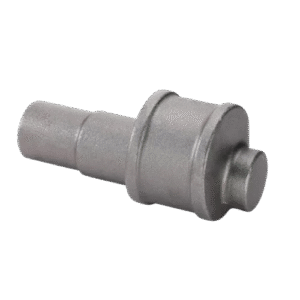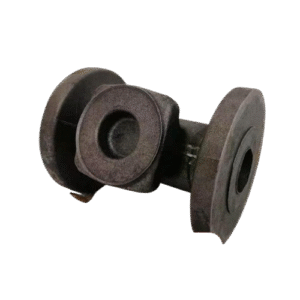1045 Steel Forging
What is 1045 Steel?
1045 steel is a standard medium-carbon steel known for its good balance of strength and ductility. The name “1045” comes from the AISI (American Iron and Steel Institute) grading system, which directly indicates its chemical composition. It is a workhorse grade commonly used in the as-forged, normalized, or heat-treated condition to achieve higher mechanical properties.

What is the Chemical Composition of 1045 Steel?
The properties of 1045 steel are determined by its specific chemical element makeup. The key elements are:
Carbon (C): 0.43% – 0.50%
This is the most important element. The carbon content places it squarely in the “medium-carbon” range, providing good hardness and strength through heat treatment after forging.Manganese (Mn): 0.60% – 0.90%
Manganese increases hardenability and strength. It also helps to deoxidize the steel during production, improving its overall quality.Phosphorus (P): 0.040% max
A residual element kept to a minimum as it can reduce ductility and toughness.Sulfur (S): 0.050% max
Another residual element. While sulfur can improve machinability, it is controlled to prevent brittleness during hot working processes like forging.
The balance of these elements makes 1045 steel exceptionally well-suited for forging.
What Forged Parts Can Be Made from 1045 Steel?
The versatility of 1045 Steel Forging allows it to be shaped into a wide array of high-strength components. Common forged parts include:
Gears and Pinions
Shafts (Crankshafts, Axle Shafts, Propeller Shafts)
Connecting Rods
Forged Flanges
Hydraulic Cylinder Rods
Agricultural Tool Components
Mining and Construction Machinery Parts
Hand Tools (e.g., wrenches, hammer heads)
Railroad Components
Essentially, any part that requires high strength, good wear resistance, and reliability under dynamic loads is an excellent candidate for 1045 steel forgings.

Key Benefits of 1045 Steel Forging
Choosing the forging process for 1045 steel offers significant advantages over other manufacturing methods like casting or machining from bar stock:
Superior Strength and Toughness: The hot forging process refines the steel’s grain structure, making it denser and more uniform. This results in superior mechanical properties, including high impact strength and fatigue resistance.
Enhanced Structural Integrity: Forgings are virtually free from voids, porosity, and inclusions that can plague cast parts, leading to greater part reliability and a longer service life.
Excellent Machinability: After forging and normalizing, 1045 steel offers good machinability, allowing for precise finishing to tight tolerabilities with minimal tool wear.
Good Wear Resistance: The medium carbon content allows 1045 steel to be heat treated (quenched and tempered) to achieve a good surface hardness, making it resistant to abrasion and wear.
Cost-Effectiveness: Forging is a highly efficient process for producing high-volume, high-strength parts with minimal material waste, making it a cost-effective solution in the long run.
The 1045 Steel Forging Process Explained
The process of creating a high-quality 1045 steel forging involves several critical steps:
Billet Cutting: Raw 1045 steel bars are cut into precise sizes called billets.
Heating: The billets are heated in a furnace to a specific forging temperature, typically between 1150°C and 1250°C (2100°F – 2280°F). This makes the steel plastic and ready for deformation.
Forging: The heated billet is placed into a set of dies (molds) and shaped under immense pressure using a hammer or press. This can be Open-Die Forging for simpler shapes or Closed-Die Forging for complex, near-net-shape parts.
Trimming: Excess material, known as flash, is trimmed off from the forged part.
Heat Treatment: The forgings are typically normalized to relieve internal stresses and refine the grain structure. They can also be quenched and tempered to achieve specific hardness and strength levels.
Finishing: Final processes such as shot blasting, machining, painting, or non-destructive testing are performed to meet the customer’s exact specifications.
We Customize 1045 Steel Forgings Based on Your Drawings
At our facility, we specialize in producing custom 1045 steel forgings tailored to your unique requirements. We understand that every application is different.
How does our custom forging service work?
Submit Your Drawings: Provide us with your detailed part drawings, CAD models, and specifications.
Engineering Review: Our engineering team will review your design to ensure it is optimized for the forging process and recommend any necessary adjustments for cost or performance.
Die Manufacturing: We design and manufacture precision forging dies in-house based on your approved design.
Production & Quality Control: Your parts are forged from certified 1045 steel, and every step of the process is monitored under strict quality control protocols.
Delivery: We deliver high-quality, custom 1045 steel forgings that meet your exact dimensional, mechanical, and performance standards.
Contact us today to discuss your project and get a competitive quote for your custom 1045 steel forging needs.
